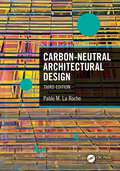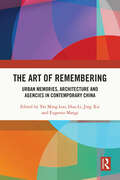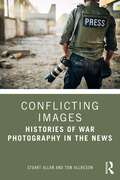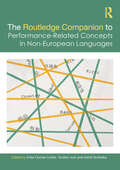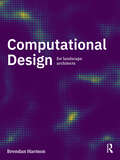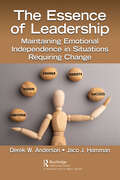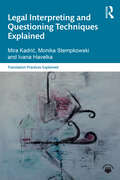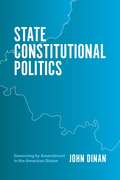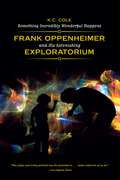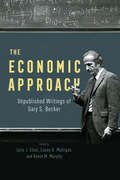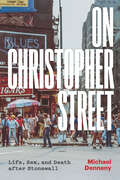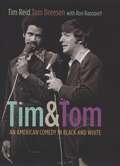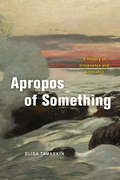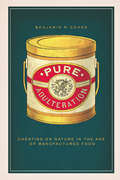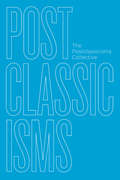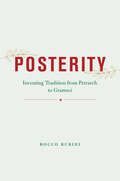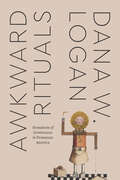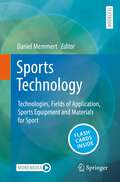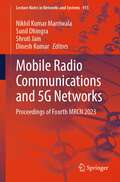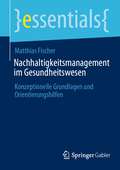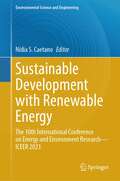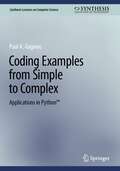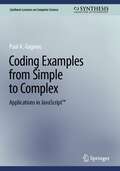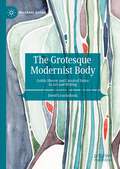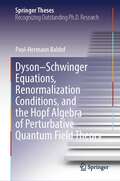- Table View
- List View
Carbon-Neutral Architectural Design
by Pablo M. La RocheThe energy used to build and operate buildings is a significant source of greenhouse gas emissions. While it is possible to reduce emissions through low-carbon design, many architects are not trained to do this. Filling an urgent need for a design reference in this emerging field, this book describes how to reduce building-related greenhouse gas emissions through appropriate design techniques. It presents strategies to achieve CO2 reductions, with an emphasis on control of energy flows through the building envelope and passive cooling and heating strategies. This new, revised edition is updated throughout and includes a new section on embodied carbon and new chapters on daylighting and nature-based cooling.Features: Adds new chapters on daylighting and nature-based cooling with numerous updates throughout the rest of the chapters Presents strategies, illustrated with examples, for new construction and existing buildings to reduce energy consumption and reduce emissions Explains the origins of CO2 emissions associated with the operation and fabrication of buildings: supplying water, disposing of waste from the building, and proposes strategies to reduce them Covers carbon calculations, thermal comfort, indigenous technology, climate‑responsive design, passive cooling and heating, solar design, air flow analysis, daylighting, building simulation and microclimate design with abundant examples Examines siting/location to design buildings that adapt and mitigate their effect on climate change
The Art of Remembering: Urban Memories, Architecture and Agencies in Contemporary China
by Hua Li Jing Xie Yat Ming Loo Eugenio MangiFocusing on the non-Western context and case studies, this book explores theories of interdisciplinary architectural thinking and the construction of urban memory in Chinese cities, with an emphasis on contemporary architecture and the diversity of agencies.China has undergone one of the fastest urbanisation and urban renewal processes in human history, but discussions of urban memory in China have tended to be practice-oriented and lack theoretical reflection. This book brings together interdisciplinary architectural scholarship to interrogate the production of urban memory and examine experiences in China. The 14 chapters explore different processes, projects, materials, architecture and urban spaces in different Chinese cities by analysing cityscapes such as temples, bridges, conservation projects, architectural design, historical architecture, memorial hall, market street, city images, custom bike, food market and so on. The book deals with different agencies and methods, tangible and intangible, in the construction of memories aimed at promoting hybridised multiple identities, and explores the interplay of different versions of memory, i.e. state, public, regional, local, individual and collective memory.This book will be essential reading for scholars and students of architecture and urbanism, cultural studies and China studies, as well as architects, urban planners and historians interested in these fields.
Conflicting Images: Histories of War Photography in the News
by Stuart Allan Tom AllbesonIn contrast with historical examinations centring the evolving role of the war correspondent, Conflicting Images focuses on the contribution of photographers and photojournalists, providing an evaluative appraisal of war photography in the news and its development from the nineteenth century to the twenty-first century.Stuart Allan and Tom Allbeson critically explore diverse genres of war photography across a broad historical sweep, encompassing events from the Crimean War (1853–56) and the Civil War in the United States (1861–65) up to and including conflicts unfolding in Syria and Ukraine. This book reflects on the relevance of different types of warfare to visual reporting, from colonial conquest via trench warfare and aerial bombardment, to the ideological dimensions of the Cold War, and ‘embedding’ and ‘winning hearts and minds’ during the ‘War on Terror’ and its aftermath. In pinpointing illustrative examples, the authors examine changing dynamics of production, dissemination, and public engagement. Readers will come to understand how current efforts to rethink the future of war photography in a digital age can benefit from a close and careful consideration of war photography’s origins, early development, and gradual, uneven transformation over the years. Conflicting Images aims to invigorate ongoing enquires and inspire new, alternative trajectories for future research and practice.This book is recommended reading for researchers and advanced students of visual journalism and conflict reporting.
The Routledge Companion to Performance-Related Concepts in Non-European Languages (ISSN)
by Erika Fischer-Lichte Torsten Jost Astrid SchenkaInvestigating more than 70 key concepts relating to the performing arts in more than six non-European languages, this volume provides a groundbreaking research tool and one-of-a-kind reference source for theatre, performance and dance studies worldwide.The Companion features in-depth explorations of and expert introductions to a select number of performance-related key concepts in Arabic, Chinese, Japanese, Korean, Yorùbá as well as the Indian languages Sanskrit, Hindi and Tamil. Key concepts—such as Furǧa فرجة in Arabic, for example, or Jiadingxing 假定性 in Chinese, Gei 芸 in Japanese, Ìparadà in Yorùbá and Imyeon 이면 in Korean—that defy easy translation from one language to another (and especially into English as the world’s lingua franca) and that reflect culturally specific ways of thinking and talking about the performing arts are thoroughly examined in in-depth articles. Written by more than 60 distinguished scholars from around the globe, the articles describe in detail each concept’s dynamic history, its flexible scope of meaning and current range of usage. The Companion also includes extensive introductions to each language section, in which internationally renowned experts explain how the presented key concepts are situated within, and are constitutive of, distinct and dynamic epistemic systems that have different yet always interlinked histories and orientations. Offers a fascinating insight into the unique histories, characteristics, and orientations of linguistically and culturally distinct epistemic systems related to the performative arts Contains extensive cross-references and bibliographies An invaluable research tool and one-of-a-kind reference source for scholars and students worldwide and across the humanities, especially in the fields of theatre, performance, dance, translation, area and cultural studies An accessible handbook for everybody interested in performance cultures and performance-related knowledge systems existing in the world today. This volume provides an invaluable research tool and one-of-a-kind reference source for scholars and students worldwide and across the humanities, especially in the fields of theatre, performance, dance, translation and area studies, history (of science and the humanities) and cultural studies.
Computational Design for Landscape Architects
by Brendan HarmonThis book is a guide to computational design for landscape architects replete with extensive tutorials. It introduces algorithmic approaches for modeling and designing landscapes. The aim of this book is to use algorithms to understand and design landscape as a generative system, i.e. to harness the processes that shape landscape to generate new forms. An algorithmic approach to design is gently introduced through visual programming with Grasshopper, before more advanced methods are taught in Python, a high-level programming language. Topics covered include parametric design, randomness and noise, waves and attractors, lidar, drone photogrammetry, point cloud modeling, terrain modeling, earthworks, digital fabrication, and more. The chapters include sections on theory, methods, and either visual programming or scripting. Online resources for the book include code and datasets so that readers can easily follow along and try out the methods presented. This book is a much-needed guide, both theoretical and practical, on computational design for students, educators, and practitioners of landscape architecture.
The Essence of Leadership: Maintaining Emotional Independence in Situations Requiring Change
by Jaco J. Hamman Derek W. AndersonThe world is experiencing a leadership crisis. The Essence of Leadership addresses this concern by empowering self-differentiated leadership. The authors draw on family systems thinking, foundational to family therapy, psychodynamic theory, a recognized lens on human nature, and proven process management tools. The core message explored over seven chapters is that a leader’s management of their own anxiety and the anxiety in a system has direct implications for their effectiveness in bringing change. The authors believe that leadership is mastering emotional and relational processes seeking to bring change according to clearly defined goals and ethical principles. As such, leadership is poorly defined as a cognitive-rational, economic, charismatic, democratic, data-based, or expert-driven "How to …" skill. Rather, anxiety’s flow and management greatly determine the likelihood of systemic transformation. After reading this book, leaders will be empowered with a growing understanding of the role anxiety plays in systemic change even as they are equipped to lead with less anxiety. Though the theory and practices in the book are applicable to all leaders, leadership is illustrated through numerous case studies from their extensive experience empowering leaders in both the for profit and nonprofit sectors. Callouts throughout the book, along with questions for reflection, invite the reader into deeper contemplation.
Legal Interpreting and Questioning Techniques Explained (Translation Practices Explained)
by Mira Kadrić Monika Stempkowski Ivana HavelkaLanguage and law are closely linked, and language is fundamental to the application of the law. Legal, criminalistic, translational and psychological aspects of communication come together in interpreted questioning (hearings, interrogations, interviews) and must be taken into account, especially since the way in which the questioning outcomes are evaluated can have far-reaching legal consequences. Building on empirical studies and practice, this accessible text provides a transdisciplinary examination of questioning methods and strategies. The institutional framework conditions of a questioning situation are examined in the context of transdisciplinary cooperation.This book also addresses the increasing use of technology and hybrid forms of translation and interpreting in the legal system, and shows different ways in which interpreters co-construct information. Chapters include summaries of key concepts and definitions, examples from existing literature combined with practical experience and the results of surveys conducted by the authors, as well as further reading and non-language-specific study activities. Activities include role plays on thematic scenarios involving different actors in criminal proceedings and discussion groups to enable reflection on ethical issues and discursive challenges.This is a vital text for both advanced students and professionals in interpreting studies and criminology.
State Constitutional Politics: Governing by Amendment in the American States
by John DinanSince the US Constitution came into force in 1789, it has been amended just twenty-seven times, with ten of those amendments coming in the first two years following ratification. By contrast, state constitutions have been completely rewritten on a regular basis, and the current documents have been amended on average 150 times. This is because federal amendments are difficult, so politicians rarely focus on enacting them. Rather, they work to secure favorable congressional statutes or Supreme Court decisions. By contrast, the relative ease of state amendment processes makes them a realistic and regular vehicle for seeking change. With State Constitutional Politics, John Dinan looks at the various occasions in American history when state constitutional amendments have served as instruments of governance. Among other things, amendments have constrained state officials in the way they levy taxes and spend money; enacted policies unattainable through legislation on issues ranging from minimum wage to the regulation of marijuana; and updated understandings of rights, including religious liberty, equal protection, and the right to bear arms. In addition to comprehensively chronicling the ways amendments shape politics in the states, Dinan also assesses the consequences of undertaking changes in governance through amendments rather than legislation or litigation. For various reasons, including the greater stability and legitimacy of changes achieved through the amendment process, he argues that it might be a more desirable way of achieving change.
Something Incredibly Wonderful Happens: Frank Oppenheimer and His Astonishing Exploratorium
by K.C. ColeHow do we reclaim our innate enchantment with the world? And how can we turn our natural curiosity into a deep, abiding love for knowledge? Frank Oppenheimer, the younger brother of the physicist J. Robert Oppenheimer, was captivated by these questions, and used his own intellectual inquisitiveness to found the Exploratorium, a powerfully influential museum of human awareness in San Francisco, that encourages play, creativity, and discovery—all in the name of understanding. In this elegant biography, K. C. Cole investigates the man behind the museum with sharp insight and deep sympathy. The Oppenheimers were a family with great wealth and education, and Frank, like his older brother, pursued a career in physics. But while Robert was unceasingly ambitious, and eventually came to be known for his work on the atomic bomb, Frank’s path as a scientist was much less conventional. His brief fling with the Communist Party cost him his position at the University of Minnesota, and he subsequently spent a decade ranching in Colorado before returning to teaching. Once back in the lab, however, Frank found himself moved to create something to make the world meaningful after the bombing of Hiroshima and Nagasaki. He was inspired by European science museums, and he developed a dream of teaching Americans about science through participatory museums. Thus was born the magical world of the Exploratorium, forever revolutionizing not only the way we experience museums, but also science education for years to come. Cole has brought this charismatic and dynamic figure to life with vibrant prose and rich insight into Oppenheimer as both a scientist and an individual.
The Economic Approach: Unpublished Writings of Gary S. Becker
by Gary S. Becker Edward L. GlaeserA revealing collection from the intellectual titan whose work shaped the modern world.As an economist and public intellectual, Gary S. Becker was a giant. The recipient of a Nobel Prize, a John Bates Clark Medal, and a Presidential Medal of Freedom, Becker is widely regarded as the greatest microeconomist in history.After forty years at the University of Chicago, Becker left a slew of unpublished writings that used an economic approach to human behavior, analyzing such topics as preference formation, rational indoctrination, income inequality, drugs and addiction, and the economics of family.These papers unveil the process and personality—direct, critical, curious—that made him a beloved figure in his field and beyond. The Economic Approach examines these extant works as a capstone to the Becker oeuvre—not because the works are perfect, but because they offer an illuminating, instructive glimpse into the machinations of an economist who wasn’t motivated by publications. Here, and throughout his works, an inquisitive spirit remains remarkable and forever resonant.
On Christopher Street: Life, Sex, and Death after Stonewall
by Michael DennenyThrough the eyes of publishing icon Michael Denneny, this cultural autobiography traces the evolution of the US’s queer community in the three decades post-Stonewall. The Stonewall Riots of 1969 and the AIDS crisis of the 1980s have been captured in minute detail, and rightly memorialized in books, on tv, and in film as pivotal and powerful moments in queer history. Yet what about the moments in between—the tumultuous decade post-Stonewall when the queer community’s vitality and creativity exploded across the country, even as the AIDS crisis emerged? Michael Denneny was there for it all. As a founder and editor of the wildly influential magazine Christopher Street and later as the first openly gay editor at a major publishing house, Denneny critically shaped publishing around gay subjects in the 1970s and beyond. At St. Martin’s Press, he acquired a slew of landmark titles by gay authors—many for his groundbreaking Stonewall Inn Editions—propelling queer voices into the mainstream cultural conversation. On Christopher Street is Denneny’s time machine, going back to that heady period to lay out the unfolding geographies and storylines of gay lives and capturing the raw immediacy of his and his contemporaries’ daily lives as gay people in America. Through forty-one micro-chapters, he uses his journal writings, articles, interviews, and more from the 1970s and ‘80s to illuminate the twists and turns of a period of incomparable cultural ferment. One of the few surviving voices of his generation, Denneny transports us back in time to share those vibrant in-between moments in gay lives—the joy, sorrow, ecstasy, and energy—across three decades of queer history.
Tim & Tom: An American Comedy in Black and White (None Ser.)
by Tim Reid Tom Dreesen Ron RapoportAs the heady promise of the 1960s sagged under the weight of widespread violence, rioting, and racial unrest, two young men--one black and one white--took to stages across the nation to help Americans confront their racial divide: by laughing at it.Tim and Tom tells the story of that pioneering duo, the first interracial comedy team in the history of show business--and the last. Tim Reid and Tom Dreesen polished their act in the nightclubs of Chicago, then took it on the road, not only in the North, but in the still-simmering South as well, developing routines that even today remain surprisingly frank--and remarkably funny--about race. Most nights, the shock of seeing an integrated comedy team quickly dissipated in uproarious laughter, but on some occasions the audience’s confusion and discomfort led to racist heckling, threats, and even violence. Though Tim and Tom perpetually seemed on the verge of making it big throughout their five years together, they grudgingly came to realize that they were ahead of their time: America was not yet ready to laugh at its own failed promise. Eventually, the grind of the road took its toll, as bitter arguments led to an acrimonious breakup. But the underlying bond of friendship Reid and Dreesen had forged with each groundbreaking joke has endured for decades, while their solo careers delivered the success that had eluded them as a team. By turns revealing, shocking, and riotously funny, Tim and Tom unearths a largely forgotten chapter in the history of comedy.
Apropos of Something: A History of Irrelevance and Relevance
by Elisa TamarkinA history of the idea of “relevance” since the nineteenth century in art, criticism, philosophy, logic, and social thought. Before 1800 nothing was irrelevant. So argues Elisa Tamarkin’s sweeping meditation on a key shift in consciousness: the arrival of relevance as the means to grasp how something that was once disregarded, unvalued, or lost to us becomes interesting and important. When so much makes claims to our attention every day, how do we decide what is most valuable right now? Relevance, Tamarkin shows, was an Anglo-American concept, derived from a word meaning “to raise or to lift up again,” and also “to give relief.” It engaged major intellectual figures, including Ralph Waldo Emerson and pragmatists and philosophers—William James, Alain Locke, John Dewey, and Alfred North Whitehead—as well as a range of critics, phenomenologists, linguists, and sociologists. Relevance is a struggle for recognition, especially in the worlds of literature, art, and criticism. Poems and paintings in the nineteenth century could now be seen as pragmatic works that make relevance and make interest—that reveal versions of events that feel apropos of our lives the moment we turn to them. Vividly illustrated with paintings by Winslow Homer, Henry Ossawa Tanner, and others, Apropos of Something is a searching philosophical and poetic study of relevance—a concept calling for shifts in both attention and perceptions of importance with enormous social stakes. It remains an invitation for the humanities and for all of us who feel tasked every day with finding the point.
Pure Adulteration: Cheating on Nature in the Age of Manufactured Food
by Benjamin R. CohenBenjamin R. Cohen uses the pure food crusades at the turn of the twentieth century to provide a captivating window onto the origins of manufactured foods in the United States. In the latter nineteenth century, extraordinary changes in food and agriculture gave rise to new tensions in the ways people understood, obtained, trusted, and ate their food. This was the Era of Adulteration, and its concerns have carried forward to today: How could you tell the food you bought was the food you thought you bought? Could something manufactured still be pure? Is it okay to manipulate nature far enough to produce new foods but not so far that you question its safety and health? How do you know where the line is? And who decides? In Pure Adulteration, Benjamin R. Cohen uses the pure food crusades to provide a captivating window onto the origins of manufactured foods and the perceived problems they wrought. Cohen follows farmers, manufacturers, grocers, hucksters, housewives, politicians, and scientific analysts as they struggled to demarcate and patrol the ever-contingent, always contested border between purity and adulteration, and as, at the end of the nineteenth century, the very notion of a pure food changed. In the end, there is (and was) no natural, prehuman distinction between pure and adulterated to uncover and enforce; we have to decide. Today’s world is different from that of our nineteenth-century forebears in many ways, but the challenge of policing the difference between acceptable and unacceptable practices remains central to daily decisions about the foods we eat, how we produce them, and what choices we make when buying them.
Postclassicisms: The Postclassicisms Collective
by The Postclassicisms CollectiveMade up of nine prominent scholars, The Postclassicisms Collective aims to map a space for theorizing and reflecting on the values attributed to antiquity. The product of these reflections, Postclassicisms takes up a set of questions about what it means to know and care about Greco-Roman antiquity in our turbulent world and offers suggestions for a discipline in transformation, as new communities are being built around the study of the ancient Greco-Roman world. Structured around three primary concepts—value, time, and responsibility—and nine additional concepts, Postclassicisms asks scholars to reflect upon why they choose to work in classics, to examine how proximity to and distance from antiquity has been—and continues to be—figured, and to consider what they seek to accomplish within their own scholarly practices. Together, the authors argue that a stronger critical self-awareness, an enhanced sense of the intellectual history of the methods of classics, and a greater understanding of the ethical and political implications of the decisions that the discipline makes will lead to a more engaged intellectual life, both for classicists and, ultimately, for society. A timely intervention into the present and future of the discipline, Postclassicisms will be required reading for professional classicists and students alike and a model for collaborative disciplinary intervention by scholars in other fields.
Posterity: Inventing Tradition from Petrarch to Gramsci
by Rocco RubiniReading a range of Italian works, Rubini considers the active transmittal of traditions through generations of writers and thinkers. Rocco Rubini studies the motives and literary forms in the making of a “tradition,” not understood narrowly, as the conservative, stubborn preservation of received conventions, values, and institutions, but instead as the deliberate effort on the part of writers to transmit a reformulated past across generations. Leveraging Italian thinkers from Petrarch to Gramsci, with stops at prominent humanists in between—including Giambattista Vico, Carlo Goldoni, Francesco De Sanctis, and Benedetto Croce—Rubini gives us an innovative lens through which to view an Italian intellectual tradition that is at once premodern and modern, a legacy that does not depend on a date or a single masterpiece, but instead requires the reader to parse an expanse of writings to uncover deeper transhistorical continuities that span six hundred years. Whether reading work from the fourteenth century, or from the 1930s, Rubini elucidates the interplay of creation and the reception underlying the enactment of tradition, the practice of retrieving and conserving, and the revivification of shared themes and intentions that connect thinkers across time. Building on his award-winning book, The Other Renaissance, this will prove a valuable contribution for intellectual historians, literary scholars, and those invested in the continuing humanist legacy.
Awkward Rituals: Sensations of Governance in Protestant America (Class 200: New Studies In Religion Ser.)
by Dana W. LoganA fresh account of early American religious history that argues for a new understanding of ritual. In the years between the American Revolution and the Civil War, there was an awkward persistence of sovereign rituals, vestiges of a monarchical past that were not easy to shed. In Awkward Rituals, Dana Logan focuses our attention on these performances, revealing the ways in which governance in the early republic was characterized by white Protestants reenacting the hierarchical authority of a seemingly rejected king. With her unique focus on embodied action, rather than the more common focus on discourse or law, Logan makes an original contribution to debates about the relative completeness of America’s Revolution. Awkward Rituals theorizes an under-examined form of action: rituals that do not feel natural even if they sometimes feel good. This account challenges common notions of ritual as a force that binds society and synthesizes the self. Ranging from Freemason initiations to evangelical societies to missionaries posing as sailors, Logan shows how white Protestants promoted a class-based society while simultaneously trumpeting egalitarianism. She thus redescribes ritual as a box to check, a chore to complete, an embarrassing display of theatrical verve. In Awkward Rituals, Logan emphasizes how ritual distinctively captures what does not change through revolution.
Sports Technology: Technologies, Fields of Application, Sports Equipment and Materials for Sport
by Daniel MemmertSports technological tools and innovations are gaining increasing significance in amateur, elite, and health-related sports. Sports technology refers to the application of scientific and technical principles, along with innovative technologies, to enhance athletic performance, increase safety, and consequently optimize the overall sporting experience. This involves the design, development, and utilization of equipment, devices, systems, and software specifically tailored for athletic purposes.This textbook aims to encompass the broad diversity of sports technology by featuring contributions from over 30 authors within their respective specialized fields, summarizing the latest insights concisely. The work is structured into five main sections: Data Acquisition Systems, Sports Equipment and Materials, Diagnostics, Evaluation and Communication, and Selected Fields of Application. Students with a connection to sports science gain a comprehensive understanding of sports technology supported by a carefully designed concept that facilitates easy delivery of learning content. Digital learning cards (SN Flashcards) reinforce the learning effect and ensure optimal exam preparation. For advanced learners, in-depth discussions on topics such as tracking data, digital training assistants, sports floor characteristics, virtual reality in sports, smartphone apps, and diagnostic tools offer additional value.
Mobile Radio Communications and 5G Networks: Proceedings of Fourth MRCN 2023 (Lecture Notes in Networks and Systems #915)
by Dinesh Kumar Shruti Jain Nikhil Kumar Marriwala Sunil DhingraThis book features selected high-quality papers from the Forth International Conference on Mobile Radio Communications and 5G Networks (MRCN 2023), held at University Institute of Engineering and Technology, Kurukshetra University, Kurukshetra, India, during August 25–26, 2023. The book features original papers by active researchers presented at the International Conference on Mobile Radio Communications and 5G Networks. It includes recent advances and upcoming technologies in the field of cellular systems, 2G/2.5G/3G/4G/5G, and beyond, LTE, WiMAX, WMAN, and other emerging broadband wireless networks, WLAN, WPAN, and various home/personal networking technologies, pervasive and wearable computing and networking, small cells and femtocell networks, wireless mesh networks, vehicular wireless networks, cognitive radio networks and their applications, wireless multimedia networks, green wireless networks, standardization of emerging wireless technologies, power management and energy conservation techniques.
Nachhaltigkeitsmanagement im Gesundheitswesen: Konzeptionelle Grundlagen und Orientierungshilfen (essentials)
by Matthias FischerDas Thema Nachhaltigkeitsmanagement gewinnt auch im Gesundheitssektor stark an Bedeutung. Nicht zuletzt, da auf Bundes- und europäischer Ebene neue rechtliche Anforderungen gestellt werden, die auch für viele Organisationen des Gesundheitswesens aktives Handeln in Richtung Nachhaltigkeit und Wahrnehmung der gesellschaftlichen Verantwortung erfordern.Dieses essential bietet Ihnen eine praxisnahe Einführung, durch die Sie sich eine Orientierung im Thema - eben mit spezifischem Fokus auf den Gesundheitsbereich - erarbeiten können. Es möchte bestehende Werke in diesem rasant wachsenden Feld nicht ersetzen, sondern um eine schnelle Orientierungshilfe ergänzen. Sie werden sowohl grundlegende Begrifflichkeiten und theoretische Hintergründe rund um das Thema Nachhaltigkeitsmanagement kennenlernen als auch Hilfestellungen zur Formulierung einer Nachhaltigkeitsstrategie oder zur Nachhaltigkeitsberichterstattung erhalten. Innerhalb kurzer Zeit können Sie sich so zunächst einen grundlegenden Überblick verschaffen und im Anschluss zum Aufbau eines Nachhaltigkeitsmanagements in Ihrer Organisation des Gesundheitswesens beitragen.
Sustainable Development with Renewable Energy: The 10th International Conference on Energy and Environment Research—ICEER 2023 (Environmental Science and Engineering)
by Nídia S. CaetanoThis proceedings book contains the full papers of the 10th edition of the International Conference on Energy and Environment Research, ICEER 2023, that took place in Madrid, Spain during October 7–9, 2023. ICEER 2023 is a joint organization of the School of Engineering (ISEP) of the Polytechnic of Porto (P.Porto) and the SCIEI, with collaboration of the Dipartimento di Ingegneria of the Università degli studi "Roma Tre", CIETI and LEPABE research groups. This book includes all the well prepared full papers presented at ICEER 2023.
Coding Examples from Simple to Complex: Applications in Python™ (Synthesis Lectures on Computer Science)
by Paul A. GagniucThis book provides a comprehensive guide to Python, which stands as the cornerstone of modern programming and is the main computer language driving software prototyping in both industry and research. The author introduces readers to the rich world of Python, taking them on a journey from the fundamentals to advanced topics, equipping them with the knowledge and skills needed to become a proficient Python developer or scientist. The book provides a treasure trove of practical examples, meticulously crafted to deepen the reader understanding of Python. This comprehensive exploration is designed to cater to novice learners as well as mature developers and scientists, equipping them with the requisite knowledge and competencies to harness the Python full potential in their respective projects. From the basics of variable naming and program structure to complex matrix operations, recursion, and object-oriented programming, this book covers it all. This book is part of a seriesof works designed to present both the examples and their explanations in various computer languages, as close to a mirror version as possible.
Coding Examples from Simple to Complex: Applications in JavaScript™ (Synthesis Lectures on Computer Science)
by Paul A. GagniucThis book provides a comprehensive guide to JavaScript, which stands as the cornerstone of modern programming and is the main computer language driving the Internet. The author introduces readers to the rich world of JavaScript, taking them on a journey from the fundamentals to advanced topics, equipping them with the knowledge and skills needed to become a proficient science and engineering oriented JavaScript developer. The book provides a treasure trove of practical examples, meticulously crafted to deepen the reader understanding of JavaScript. This comprehensive exploration is designed to cater to novice learners as well as mature developers and scientists, equipping them with the requisite knowledge and competencies to harness the JavaScript full potential in their respective projects. This book is part of a series of works designed to present both the examples and their explanations in various computer languages, as close to a mirror version as possible.
The Grotesque Modernist Body: Gothic Horror and Carnival Satire in Art and Writing (Palgrave Gothic)
by David CruickshankThe Grotesque Modernist Body explores how and why modernist authors drew on the traditions of the grotesque body in order to represent modern reality accurately. The author employs the concept of the grotesque body as a theoretical framework with which to examine rigorously a range of modernist novels, poems and visual media by Conrad, Lewis, Eliot and Barnes, alongside their historical contexts and theories of humour and horror. This monograph challenges the prevailing narrative of modernism’s abstract, psychological and impersonal ‘inward turn’ by tracing its mechanical-animal hybrid bodies back tothe medieval carnival satire of Rabelais, the gothic horror of the long nineteenth century, from Hoffmann, Shelley and Poe, to H.G. Wells and Henry James, and the uncanny, dreamlike art of Goya and Rousseau.
Dyson–Schwinger Equations, Renormalization Conditions, and the Hopf Algebra of Perturbative Quantum Field Theory (Springer Theses)
by Paul-Hermann BaldufThis book offers a systematic introduction to the Hopf algebra of renormalization in quantum field theory, with a special focus on physical motivation, the role of Dyson–Schwinger equations, and the renormalization group. All necessary physical and mathematical constructions are reviewed and motivated in a self-contained introduction. The main part of the book concerns the interplay between Dyson–Schwinger equations (DSEs) and renormalization conditions. The book is explicit and consistent about whether a statement is true in general or only in particular renormalization schemes or approximations and about the dependence of quantities on regularization parameters or coupling constants. With over 600 references, the original literature is cited whenever possible and the book contains numerous references to other works discussing further details, generalizations, or alternative approaches. There are explicit examples and remarks to make the connection from the scalar fields at hand toQED and QCD. The book is primarily targeted at the mathematically oriented physicist who seeks a systematic conceptual overview of renormalization, Hopf algebra, and DSEs. These may be graduate students entering the field as well as practitioners seeking a self-contained account of the Hopf algebra construction. Conversely, the book also benefits the mathematician who is interested in the physical background of the exciting interplay between Hopf algebra, combinatorics and physics that is renormalization theory today.
